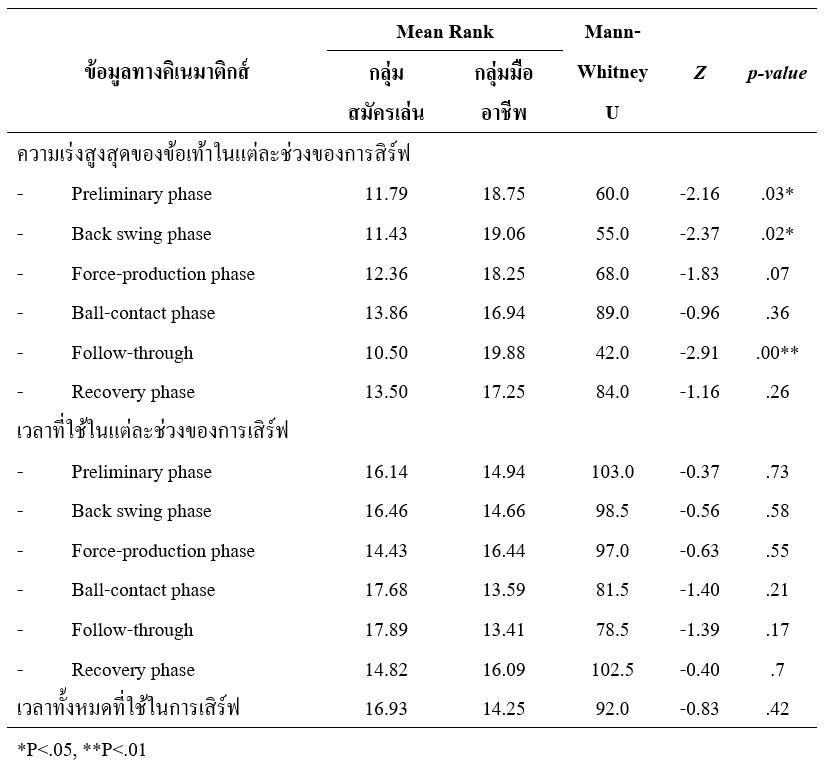KINEMATIC ANALYSIS OF BACK FOOT SERVE IN MALE SEPAK TAKRAW PLAYERS.
Main Article Content
Abstract
Purpose: To study and compare the kinematic data of back foot sepak takraw services.
Subjects: Sixteen Male Sepak Takraw players in serve position aged between 18-30 years. Divided into two groups; eight male sepak takraw professional players and seven male sepak takraw amateur players.
Methods: Each player served with back foot 20services, landed the ball on the space between right side and back players (Tekong) for at least 5 successful services on target space were required. If the subject could not serve up to 5 landed in target space, he would be allowed to get dynamic rest for 10 minutes and started another 20 services again. The first and second of maximum serving speed were analyzed. The Independent t-test and Mann-Whitney Test were used to compare mean and standard deviation of kinematics data. The level of significance at p-value ≤ 0.05.
Results: The results showed the highly significant differences (p<0.01) between groups in ball velocity, and maximum acceleration of ankle in follow-through phase. There were significant differences (p<0.05) between groups in maximum velocity of ankle in preliminary phase and follow-through phase and maximum acceleration of ankle in preliminary phase and back swing phase.
Conclusion: The velocity and acceleration of ankle in preliminary, back swing, force-production and follow-through phase might be the major key to control the ball velocity.
Article Details

This work is licensed under a Creative Commons Attribution-NonCommercial-NoDerivatives 4.0 International License.
References
Deepracha, T. (2013). A Comparison of kinematic analysis of movement in high kick of Muay Thai amatuer boxers in 42 nd Thailand natinal games. (Master’s Thesis), Faculty of Sports Science Chulalongkorn University Bangkok.
Hamdan, N., Suwarganda, E., and Wilson, B. (2012). Factors Correlated with Sepak Takraw Serve Speed Paper presented at the 30th Annual Conference of Biomechanics in Sports, Melbourne
Laha, W. (2011). the development of tennis serving skills with strength and flexibility training of Loei RajaBhat University students. Journal of Sports Science and Technology., 11(2), 13-32.
Panjamanas, J. (2013). The analysis of service patterns of the 26th KING’S Cup Sepaktakraw World Championship. (Master’s Thesis), Faculty of Sports Science Chulalongkorn University., Bangkok.
Sekaew, W. (2014). Effect of 4-week Plyometric Training Pattern on Muscle Power and Agility in Soccer Players. (Master of Science (Sports Science)), Faculty of Sports Science, Kasetsart University.,
Sidthilaw, S., inon, K., and Pitaksathienkul, C. (2008). Biomechanical analysis of sepak takraw serves in 24th SEA Games. Bangkok: Express Transportation Organization of Thailand.
Sidthilaw, S., Maitrechit, V., and Katkaew, W. (2004). Three-dimension Kinematic analysis of Sepak Takraw serves in the 16th King's Cup Sepak Takraw world championship. Bangkok: Express Transportation Organization of Thailand.
Sujae, I. H., and Koh, M. (2008). Technique analysis of the kuda and sila serves in sepaktakraw. Sports Biomech, 7(1), 72-87.
Suriyaprakarn, T., and Promin, S. (2012). The relationship between competition results and sepak takraw playing patterns in the 38th national games. Journal of liberal arts, Prince of Songkla University, 4(1), 92-104.
Usman, J., Wan Abu, A. B., Rambely, A. S., and Abu Osman, N. A. (2002). A comparative study on kinematics parameters between the sepak kuda serve and the sepak sila serve in Sepak Takraw. Paper presented at the XXth International Symposium on Biomechanics in Sports Ottawa Canada.


